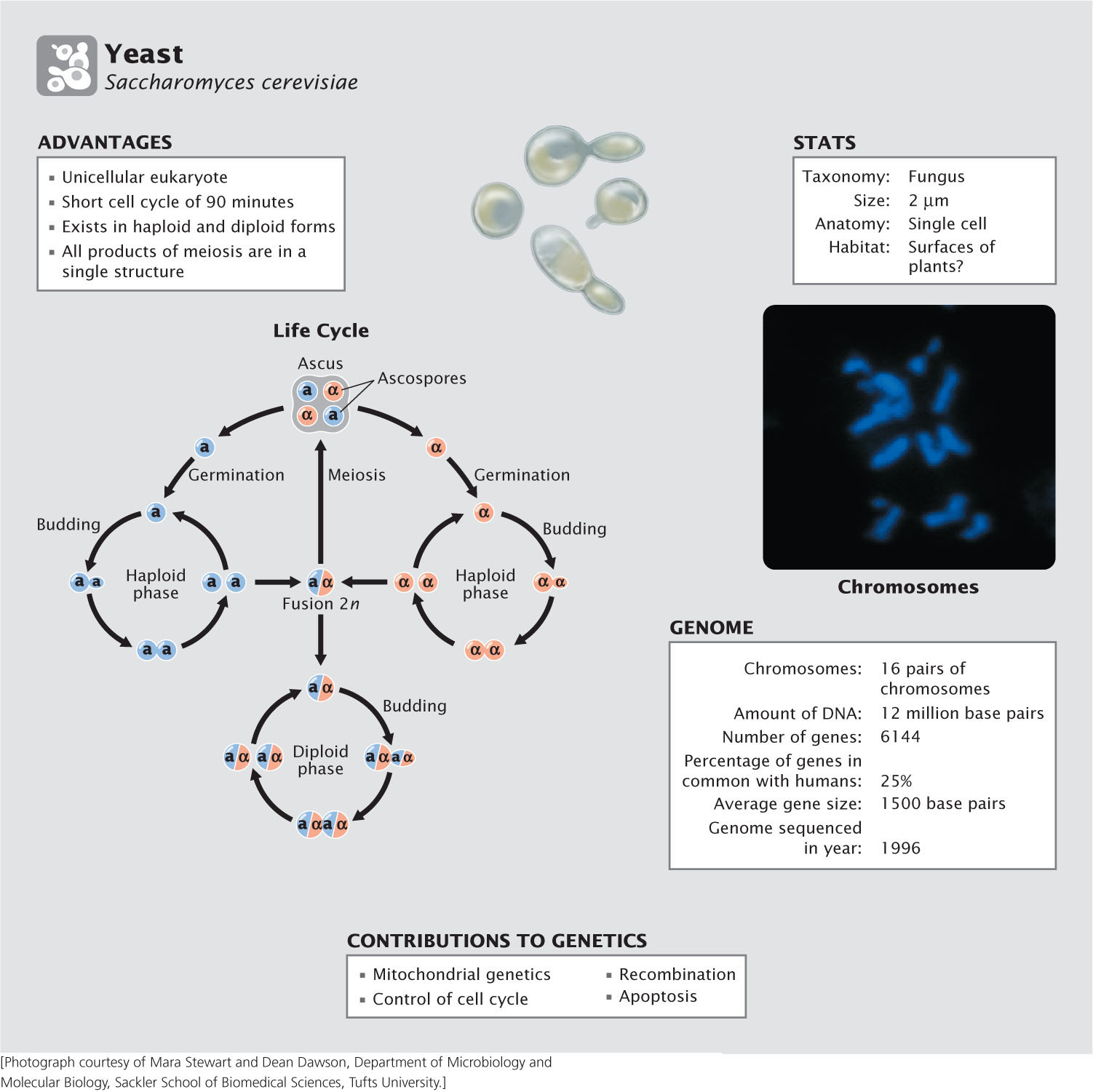The Yeast Saccharomyces cerevisiae
Common baker’s yeast (Saccharomyces cerevisiae) has been widely adopted as a simple model system for the study of eukaryotic genetics. Long used for baking bread and making beer, yeast has more recently been utilized for the production of biofuels. Louis Pasteur identified S. cerevisiae as the microorganism responsible for fermentation in 1857, and its use in genetic analysis began about 1935. Having been the subject of extensive studies in classical genetics for many years, yeast genes are well known and characterized. At the same time, yeast’s unicellular nature makes it amenable to molecular techniques developed for bacteria. Thus, yeast combines both classical genetics and molecular biology to provide a powerful model for the study of eukaryotic genetic systems.
Advantages of yeast as a model genetic organism
The great advantage of yeast is that it not only is a eukaryotic organism, with genetic and cellular systems similar to those of other, more-complex eukaryotes such as humans, but also is unicellular, with many of the advantages of manipulation found with bacterial systems. Like bacteria, yeast cells require little space, and large numbers of cells can be grown easily and inexpensively in the laboratory.
Yeast exists in both diploid and haploid forms. When haploid, the cells possess only a single allele at each locus, which means that the allele will be expressed in the phenotype; unlike the situation in diploids, there is no dominance through which some alleles mask the expression of others. Therefore, recessive alleles can be easily identified in haploid cells, and then the interactions between alleles can be examined in the diploid cells.
Another feature that makes yeast a powerful genetic model system is that, subsequent to meiosis, all of the products of a meiotic division are present in a single structure called an ascus (see the next subsection) and remain separate from the products of other meiotic divisions. The four cells produced by a single meiotic division are termed a tetrad. In most organisms, the products of different meiotic divisions mix, and so identification of the results of a single meiotic division is impossible. For example, if we were to isolate four sperm cells from the testes of a mouse, it is extremely unlikely that all four would have been produced by the same meiotic division. Having tetrads separate in yeast allows us to directly observe the effects of individual meiotic divisions on the types of gametes produced and to more easily identify crossover events. The genetic analysis of a tetrad is termed tetrad analysis.
Yeast has been subjected to extensive genetic analysis, and thousands of mutants have been identified. In addition, many powerful molecular techniques developed for manipulating genetic sequences in bacteria have been adapted for use in yeast. Yet, in spite of a unicellular structure and ease of manipulation, yeast cells possess many of the same genes found in humans and other complex multicellular eukaryotes, and many of these genes have identical or similar functions in these eukaryotes. Thus, the genetic study of yeast cells often contributes to our understanding of other, more-complex eukaryotic organisms, including humans.
Life cycle of yeast
As stated earlier, Saccharomyces cere-visiae can exist as either haploid or diploid cells. Haploid cells usually exist when yeast is starved for nutrients and reproduce mitotically, producing identical, haploid daughter cells through budding. Yeast cells can also undergo sexual reproduction. There are two mating types, a and α haploid cells of different mating types fuse and then undergo nuclear fusion to create a diploid cell. The diploid cell is capable of budding mitotically to produce genetically identical diploid cells. Starvation induces the diploid cells to undergo meiosis, resulting in four haploid nuclei, which become separated into different cells, producing haploid spores. Because the four products of meiosis (a tetrad) are enclosed in a common structure, the ascus, all the products of a single meiosis can be isolated (tetrad analysis).
The yeast genome
Saccharomyces cerevisiae has 16 pairs of typical eukaryotic chromosomes. The rate of recombination is high, giving yeast a relatively long genetic map compared with those of other organisms. The genome of S. cerevisiae contains 12 million base pairs, plus the 2 million to 3 million base pairs of rRNA genes. In 1996, S. cerevisiae was the first eukaryotic organism whose genome was completely sequenced.
Genetic techniques with yeast
One advantage of yeast to researchers is the use of plasmids to transfer genes or DNA sequences of interest into cells. Yeast cells naturally possesses a circular plasmid, named 2μ, that is 6300 bp long and is transmitted to daughter cells in mitosis and meiosis. This plasmid has an origin of replication recognized by the yeast replication system, and so it replicates autonomously in the cell. The 2μ plasmid has been engineered to provide an efficient vector for transferring genes into yeast. In other cases, bacterial plas-mids have been adapted for use in yeast. Some of them undergo homologous recombination with the yeast chromosome, transferring their sequences to the yeast chromosome. Shuttle vectors, which can be propagated in both bacteria and yeast, are particularly effective. Such vectors make it possible to construct and manipulate gene sequences in bacteria, where often more powerful techniques are available for genetic manipulation and selection, and then transfer the gene sequences into yeast cells, where their function can be tested.
835

Plasmids are limited in the size of DNA fragments that they can carry. Yeast artificial chromosomes (YACs)—engineered DNA fragments that contain centromeric and telomeric sequences and segregate like chromosomes in meiosis and mitosis—overcome this limitation; YACs can hold DNA fragments as large as several hundred thousand base pairs.
836